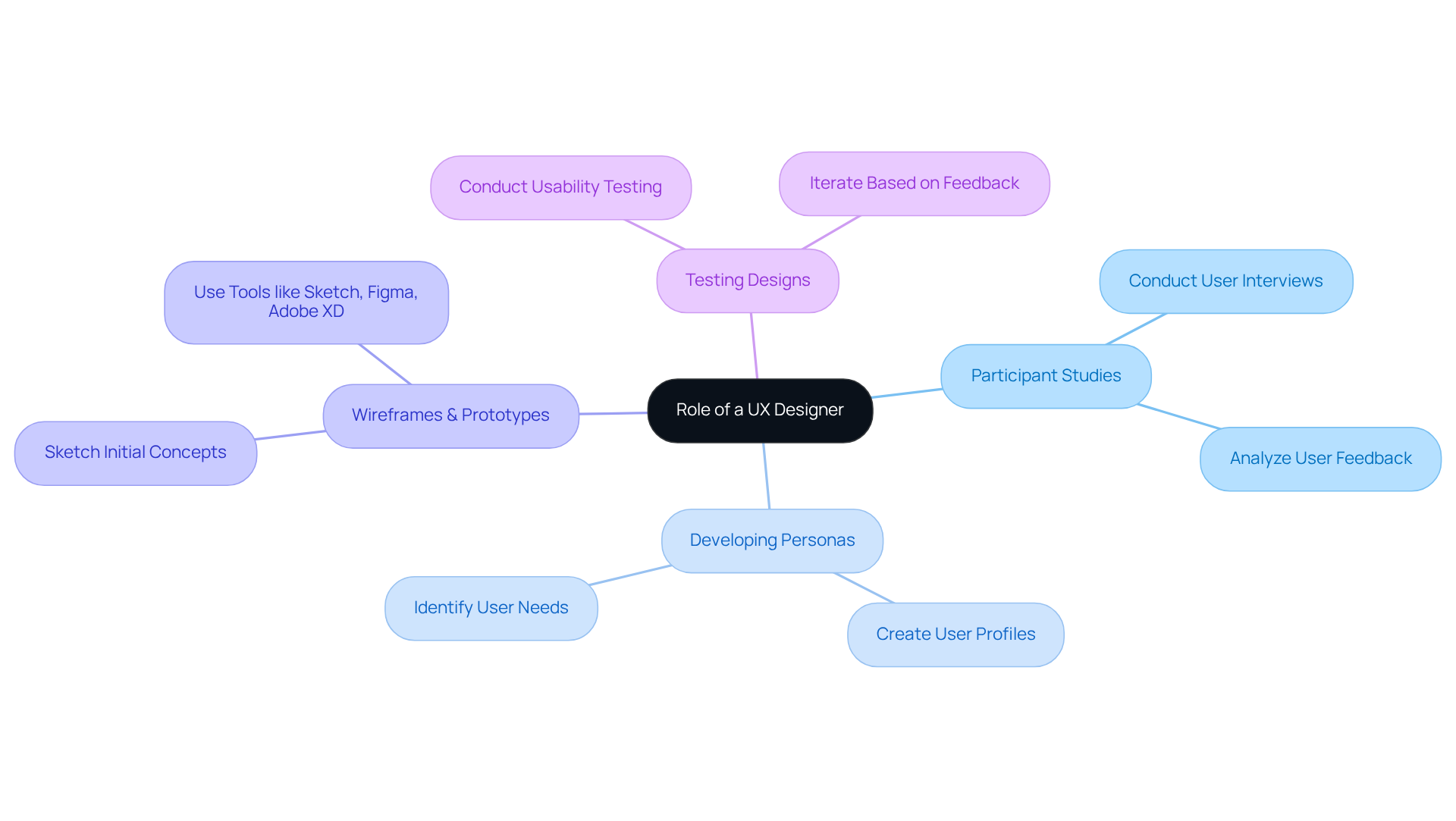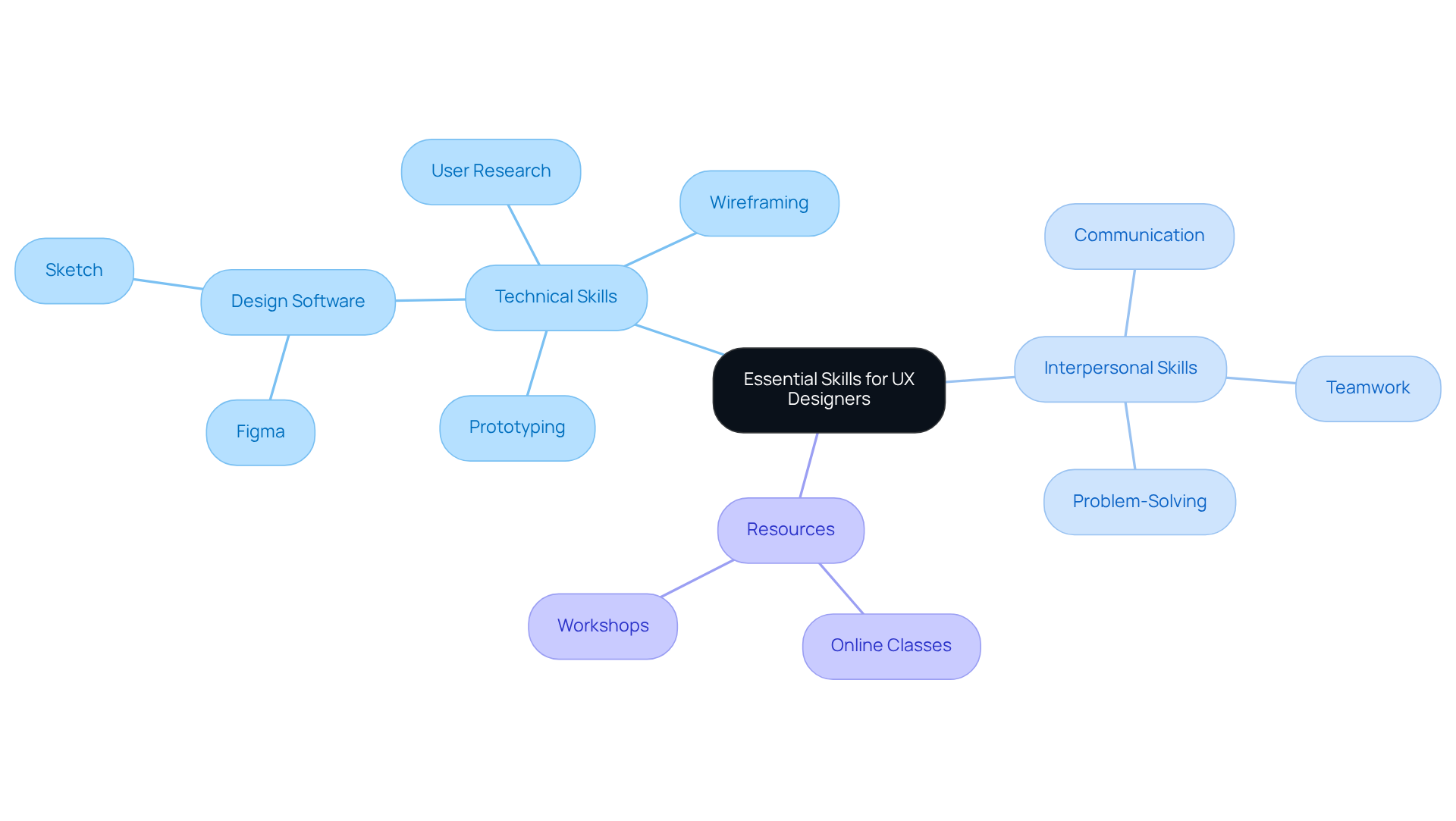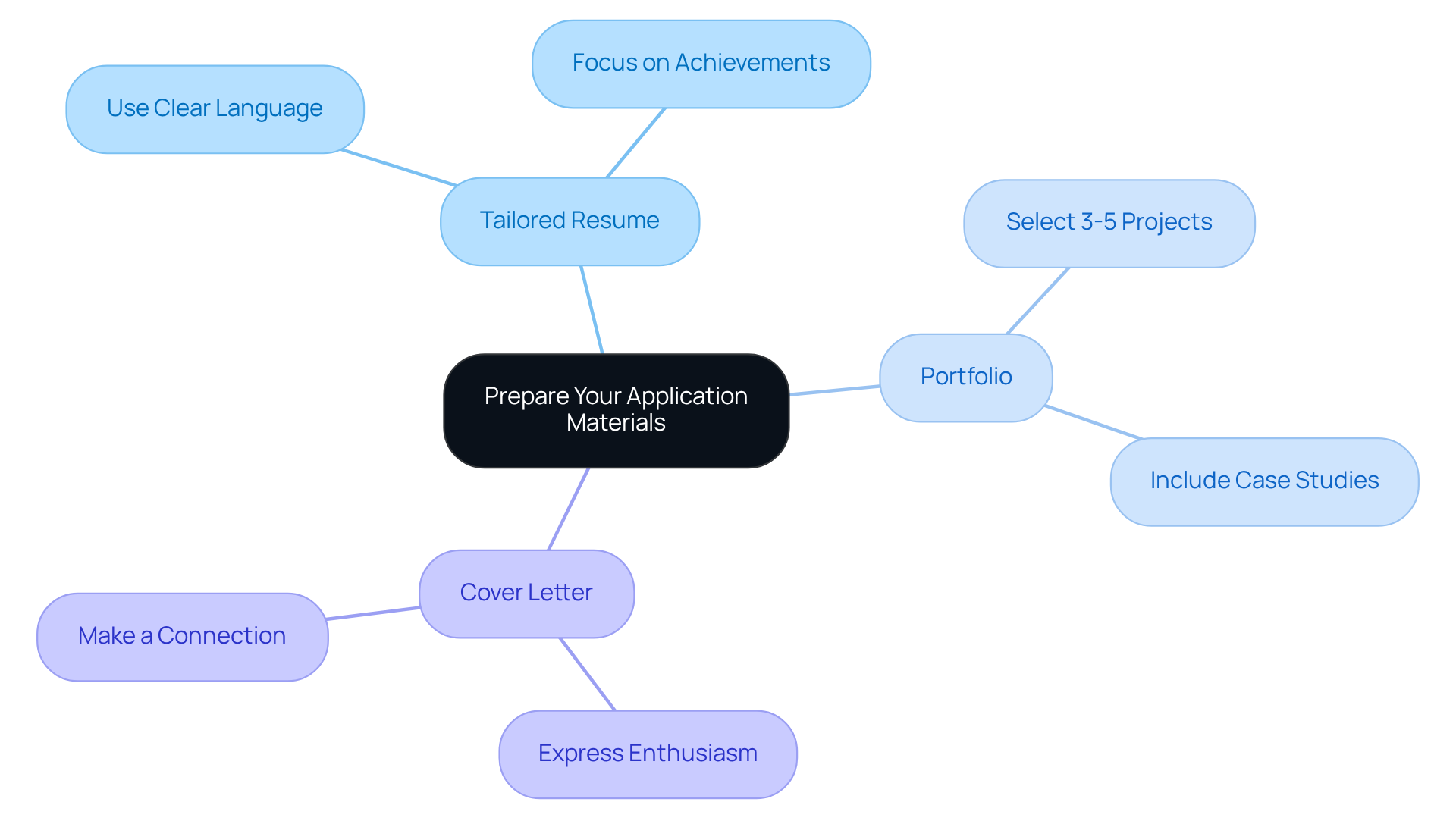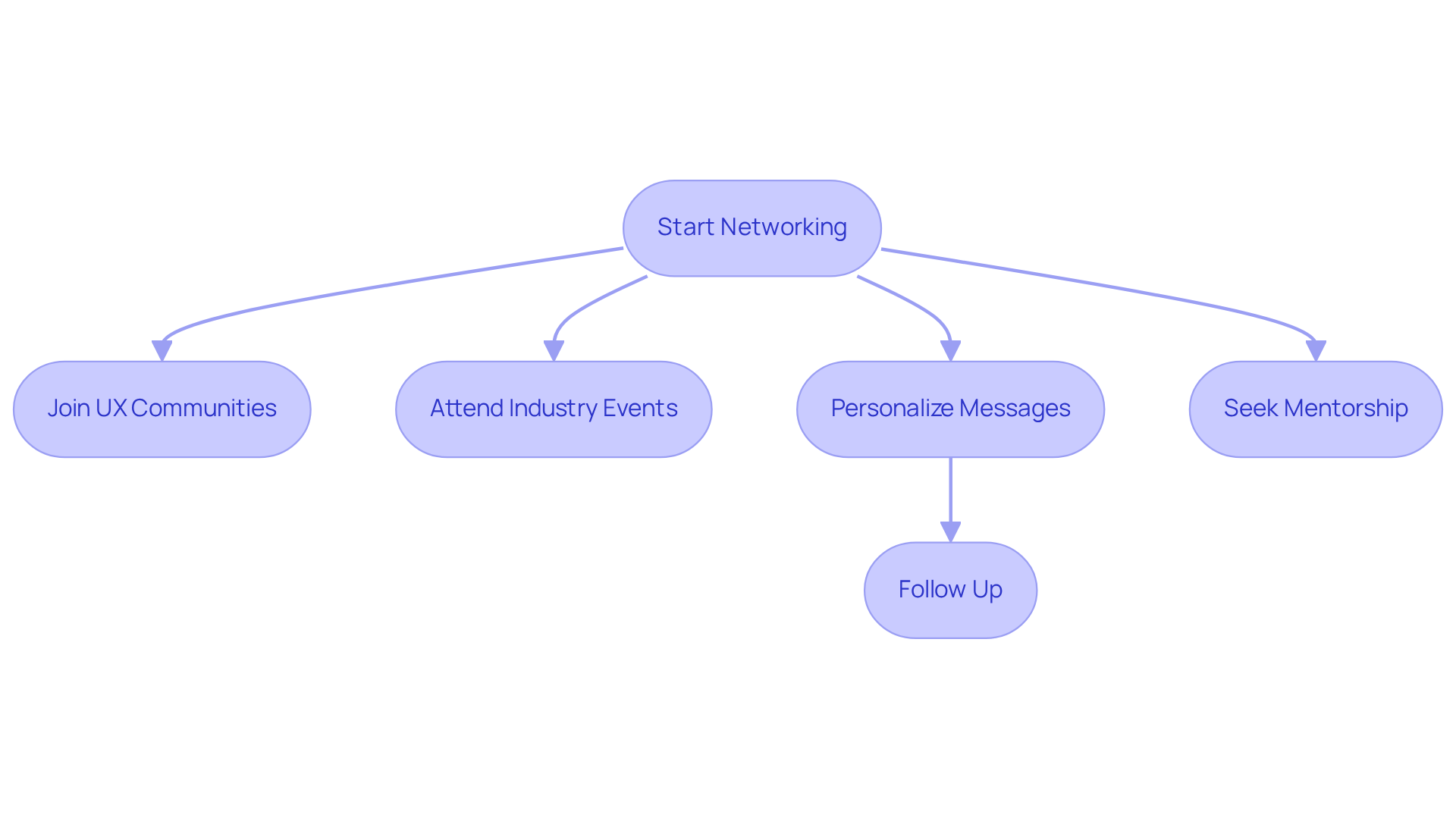Overview
Securing a UX designer vacancy can feel daunting, as candidates often grapple with developing essential skills in both technical and interpersonal areas. This challenge can stir feelings of uncertainty and overwhelm, especially in a competitive field. However, it’s important to remember that you are not alone in this journey.
Focusing on tailored application materials that effectively showcase your experiences can make a significant difference. A strong portfolio is not just a collection of work; it’s a reflection of your growth and creativity. Networking with industry professionals can open doors and provide invaluable insights, while continuous learning nurtures your confidence and marketability.
Embrace these opportunities to enhance your skills and connect with others in the field. Together, we can navigate the complexities of the UX landscape and empower one another to succeed.
Introduction
Securing a position as a UX designer can feel like navigating a labyrinth, where the path is filled with numerous skills and qualifications needed to truly stand out in a competitive field. Many aspiring designers grapple with this challenge, feeling overwhelmed by the intricacies of the role. This article aims to shed light on the essential steps you can take to not only understand these complexities but also to effectively showcase your unique talents and experiences. As the demand for skilled UX professionals continues to rise, it’s natural to wonder: how can you bridge the gap between technical know-how and interpersonal finesse to land that coveted job? Together, let’s explore this journey, acknowledging the struggles while finding a supportive path forward.
Understand the Role of a UX Designer
As a UX specialist, you may often find yourself facing the challenge of creating user-focused layouts that not only enhance usability but also bring joy to users. This responsibility can feel overwhelming at times, especially when you consider the importance of:
- Performing participant studies
- Developing personas
- Crafting wireframes and prototypes
- Rigorously testing designs to ensure they truly meet the needs of your audience
Recognizing these duties is crucial, as it allows you to tailor your applications to highlight the most .
For instance, if you have experience in client analysis or prototyping, it’s essential to showcase these strengths in your resume and portfolio. Remember, you are not alone in this journey; many have walked this path and found success by emphasizing their unique skills. Additionally, taking the time to familiarize yourself with industry-standard tools like Sketch, Figma, or Adobe XD can significantly enhance your profile, setting you apart from other candidates. Embrace this opportunity for growth, and know that with each step, you are building a brighter future for yourself in the UX field.

Identify Essential Skills and Qualifications
If you're looking to secure a UX designer vacancy, it's important to recognize that many applicants face challenges in balancing their technical and interpersonal skills. You might find that essential technical abilities, such as proficiency in design software like Figma or Sketch, user research techniques, wireframing, and prototyping, are areas where you feel less confident. This can be daunting, especially when you consider how crucial interpersonal skills—like communication, teamwork, and problem-solving—are in this collaborative field. UX designers often work in teams, and the ability to effectively convey your ideas is vital.
But don’t worry; you're not alone in this journey. Many aspiring designers grapple with similar feelings of uncertainty. A strong portfolio that showcases your design process and case studies can make a significant difference in your application for the UX designer vacancy, reflecting not just your skills but also your growth as a designer. If you identify gaps in your knowledge, consider enrolling in online classes or participating in workshops. These resources can be incredibly beneficial in developing the skills you need while connecting with others who share your aspirations. Remember, every step you take is a step toward your goal, and there are supportive communities out there ready to help you succeed.

Prepare Your Application Materials
When preparing your application materials, it’s important to begin with a that truly reflects your relevant experience and skills. Many applicants struggle with this, often feeling overwhelmed by the need to stand out. It’s essential to use clear, concise language, focusing on your achievements rather than just listing duties. This approach not only highlights your capabilities but also alleviates the stress of the application process.
For your portfolio, consider selecting 3-5 projects that showcase your creative journey—from the initial research to the final presentation. It can be challenging to convey your unique process, but including case studies that detail your role, the obstacles you faced, and the solutions you implemented can make a significant difference. Remember, your portfolio should be visually appealing and easy to navigate; this reflects your aesthetic sensibility and can resonate with potential employers.
Additionally, think about crafting a cover letter that expresses your genuine enthusiasm for UX. This is your chance to clarify why you are a suitable candidate for the specific position. Sharing your passion can create a connection with the reader, making your application not just a submission, but a conversation. By approaching your application with care and thoughtfulness, you’re not just showcasing your skills; you’re inviting others to see the person behind the resume.

Network with Industry Professionals
Networking with industry professionals can often feel daunting, leaving many feeling isolated in their journey. It's a common struggle, but you don't have to face it alone. By joining UX design communities on platforms like LinkedIn, Reddit, or specialized forums, you can start to build connections that might lead to new opportunities. Attending industry events, webinars, and meetups is another wonderful way to meet fellow designers and potential employers who share your passion.
When you reach out to others, remember to personalize your messages. This small gesture can show genuine interest in their work and open the door to valuable advice and insights. Building relationships is a gradual process, so it's important to be consistent in your efforts. Following up with your contacts periodically can help keep those connections alive and thriving.
Consider seeking mentorship from experienced designers who can offer guidance and support as you navigate your career path. Their insights can be invaluable, helping you to in this vibrant community. Remember, you are not alone in this journey; many have walked this path before you and are eager to help you along the way.

Conclusion
Securing a position as a UX designer can feel overwhelming, as it involves a multifaceted approach that combines:
- Understanding the role
- Honing essential skills
- Preparing effective application materials
- Networking within the industry
Many aspiring designers grapple with the complexities of standing out in a competitive job market. By recognizing the responsibilities of a UX designer and emphasizing relevant experiences, you can tailor your applications to shine amidst the crowd.
A strong portfolio is crucial; it should not only showcase your technical skills but also highlight your design process and problem-solving capabilities. Engaging with industry professionals through networking can be a game changer, opening doors to mentorship and new opportunities. This journey, while daunting, can be made easier by personalizing your outreach and nurturing connections within the UX community, significantly enhancing your career prospects.
Ultimately, becoming a successful UX designer transcends individual skills; it’s about building relationships and embracing continuous learning. By taking these steps, you can embark on a rewarding career in UX design, where creativity meets user-centric solutions. Remember, taking action today can pave the way for a fulfilling future in this dynamic field. You are not alone in this journey—embracing these insights can help you thrive.
Frequently Asked Questions
What is the primary role of a UX designer?
The primary role of a UX designer is to create user-focused layouts that enhance usability and bring joy to users.
What key responsibilities do UX designers have?
UX designers are responsible for performing participant studies, developing personas, crafting wireframes and prototypes, and rigorously testing designs to ensure they meet the needs of their audience.
Why is it important for UX designers to recognize their duties?
Recognizing their duties is crucial for UX designers as it allows them to tailor their applications to highlight the most relevant experiences and skills.
How can UX designers showcase their strengths?
UX designers can showcase their strengths by emphasizing their experience in areas such as client analysis or prototyping in their resume and portfolio.
What tools should UX designers familiarize themselves with?
UX designers should familiarize themselves with industry-standard tools like Sketch, Figma, or Adobe XD to enhance their profiles and stand out from other candidates.
What mindset should UX designers adopt for their career growth?
UX designers should embrace opportunities for growth and recognize that each step they take contributes to building a brighter future in the UX field.




